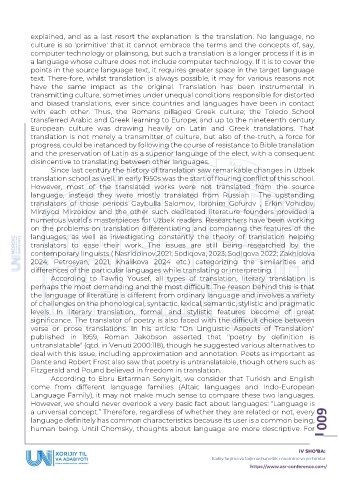Page 602 - Konferensiya to'plami - 1 (ASR)
P. 602
explained, and as a last resort the explanation is the translation. No language, no
culture is so 'primitive' that it cannot embrace the terms and the concepts of, say,
computer technology or plainsong, but such a translation is a longer process if it is in
a language whose culture does not include computer technology. If it is to cover the
points in the source language text, it requires greater space in the target language
text. There-fore, whilst translation is always possible, it may for various reasons not
have the same impact as the original. Translation has been instrumental in
transmitting culture, sometimes under unequal conditions responsible for distorted
and biased translations, ever since countries and languages have been in contact
with each other. Thus, the Romans pillaged Greek culture; the Toledo School
transferred Arabic and Greek learning to Europe; and up to the nineteenth century
European culture was drawing heavily on Latin and Greek translations. That
translation is not merely a transmitter of culture, but also of the-truth, a force for
progress, could be instanced by following the course of resistance to Bible translation
and the preservation of Latin as a superior language of the elect, with a consequent
disincentive to translating between other languages.
Since last century the history of translation saw remarkable changes in Uzbek
translation school as well. In early 1950s was the start of flouring conflict of this school.
However, most of the translated works were not translated from the source
language, instead they were mostly translated from Russian . The upstanding
translators of those periods Gaybulla Salomov, Ibrohim Gofurov , Erkin Vohidov,
Mirziyod Mirzoidov and the other such dedicated literature founders provided a
numerous world’s masterpieces for Uzbek readers. Researchers have been working
on the problems on translation differentiating and comparing the features of the
languages, as well as investigating constantly the theory of translation helping
translators to ease their work. The issues are still being researched by the
contemporary linguists ( Nasriddinov,2021; Sodiqova, 2023; Sodiqova 2022; Zakhidova
2024; Petrosyan, 2021, Khalikova 2024 etc.) categorizing the similarities and
differences of the particular languages while translating or interpreting.
According to Tawfiq Yousef, all types of translation, literary translation is
perhaps the most demanding and the most difficult. The reason behind this is that
the language of literature is different from ordinary language and involves a variety
of challenges on the phonological, syntactic, lexical, semantic, stylistic and pragmatic
levels. In literary translation, formal and stylistic features become of great
significance. The translator of poetry is also faced with the difficult choice between
verse or prose translations. In his article "On Linguistic Aspects of Translation"
published in 1959, Roman Jakobson asserted that "poetry by definition is
untranslatable" (qtd. in Venuti 2000:118), though he suggested various alternatives to
deal with this issue, including approximation and annotation. Poets as important as
Dante and Robert Frost also saw that poetry is untranslatable, though others such as
Fitzgerald and Pound believed in freedom in translation.
According to Ebru Ertarman Senyigit, we consider that Turkish and English
come from different language families (Altaic languages and Indo-European
Language Family), it may not make much sense to compare these two languages.
However, we should never overlook a very basic fact about languages: “Language is
a universal concept.” Therefore, regardless of whether they are related or not, every
language definitely has common characteristics because its user is a common being, 600
human being. Until Chomsky, thoughts about language are more descriptive. For
IV SHO‘BA:
Badiiy tarjima va tarjimashunoslik: muammo va yechimlar
https://www.asr-conference.com/

